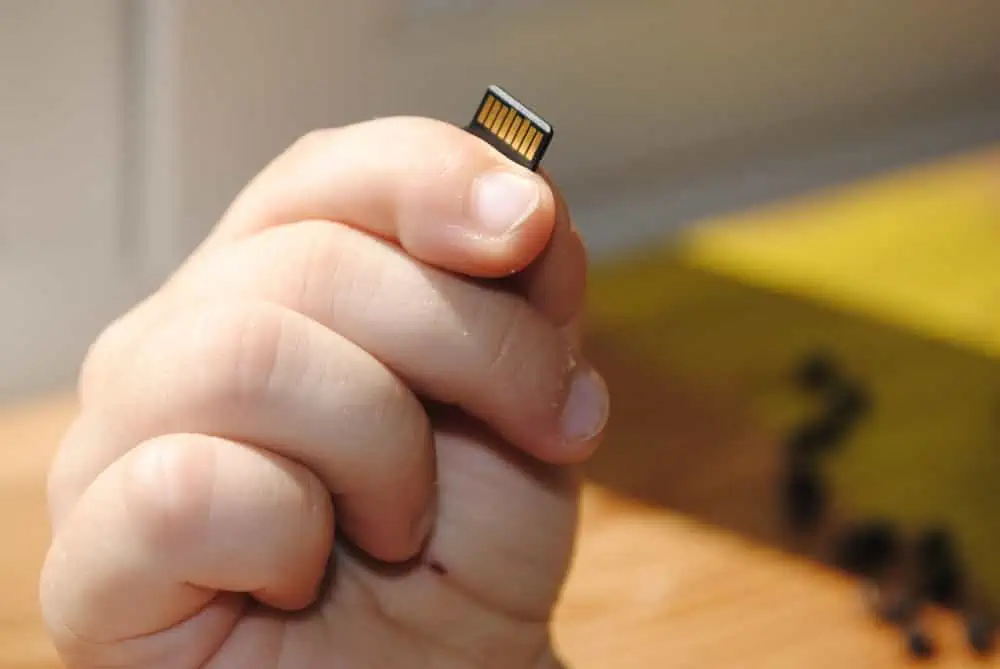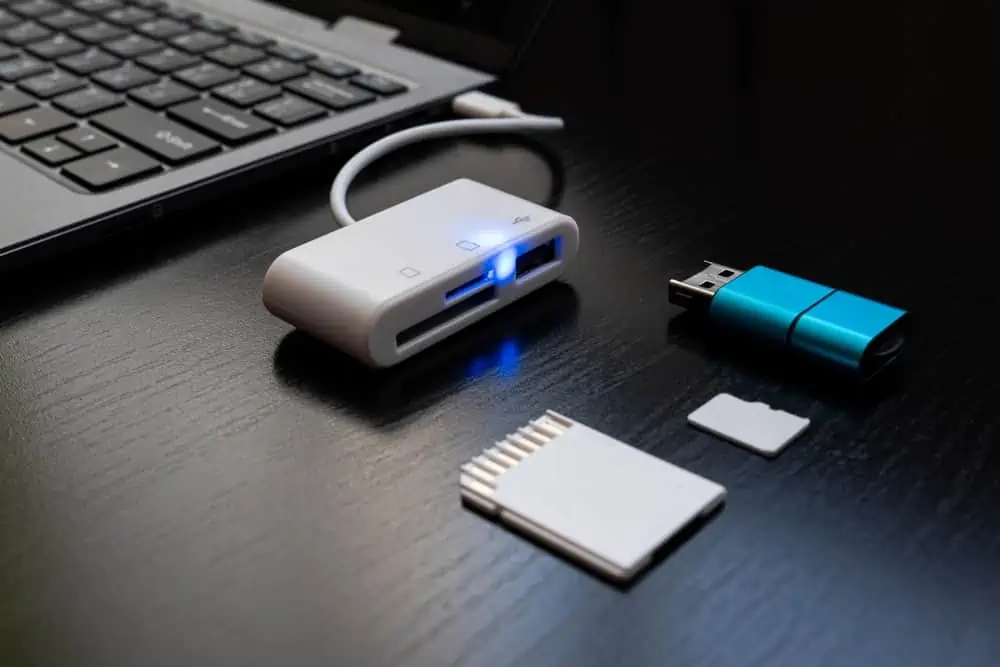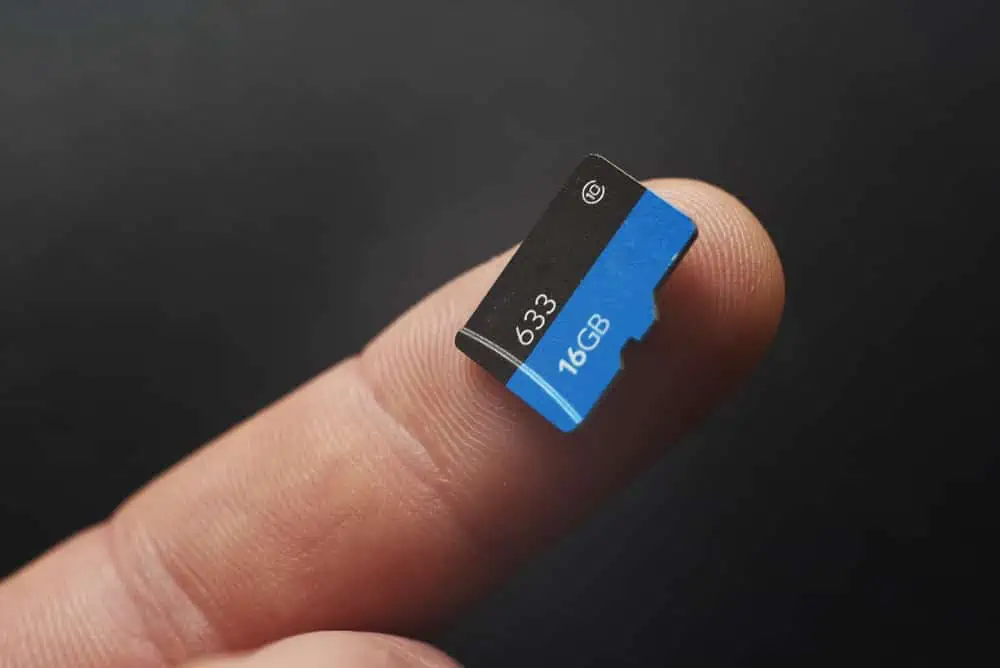Wondering how eMMC flash memory storage compares to SSD? Then, you’re in luck, as this article explains all you need to know about eMMC flash memory storage.
Overview
eMMC stands for embedded Multi-Media Card. The eMMC acronym has two important elements – “embedded” and “Multi-Media Card”
Based on this, the first thing to note is that eMMC flash memory is based on the Multi-Media Card standard. Secondly, manufacturers “embed” (solder) the device into the main circuit board of the host device.
For example, if a smartphone uses the eMMC storage, the eMMC will be soldered to the smartphone’s main motherboard. On the other hand, if used for a laptop, manufacturers will solder the eMMC directly to the laptop’s motherboard.
The implication of soldering eMMC into a device’s motherboard is that users will not be able to upgrade the storage. So, when you buy a device with eMMC storage, you need to consider the upgradability limitation.
So, in terms of technology, what does eMMC Flash Memory mean?
eMMC storage is made of NAND flash memory. Specifically, 3 components make up eMMC – the MMC (Multi-Media Card) interface, the NAND flash memory, and the flash memory controller.
In the next section, I’ll explain how the 3 components work.
Before I move on though, it is important to note that device manufacturers use the NAND flash memory technology in other common storage devices. For example, manufacturers use this same flash memory technology in USB sticks, SD cards, and solid-state drives (SSD).
How Does eMMC Flash Memory Work?
In the last section, I mentioned that there are 3 components of eMMC – the MMC interface, the NAND flash memory, and the flash memory controller. I also said that the entire eMMC device is soldered into the host device’s main circuit board (or motherboard).
Specifically, two of the eMMC components – the flash memory and the flash memory controller – are built into an Integrated Circuit (IC) chip. Then, the IC chip is embedded into the motherboard.
The eMMC’s IC controller handles the task of placing data into storage. This frees up the CPU from performing this task.
The fact that the eMMC’s controller handles placing data in storage is a very important piece of information. One implication of this is improved speed.
Why?
Well, if the eMMC takes the load of reading and writing data away from the CPU, the CPU can focus on other tasks.
In terms of actual data storage, eMMC flash memory writes data into a pool of NAND flash. One important feature of NAND is that they are non-volatile memory – meaning that they do not need external power to retain their data.
Features Of eMMC Flash Memory Technology
So far I have given a quick overview of eMMC flash storage. I have also explained how this low-cost flash memory technology works.
In the following sub-sections, you’ll learn about the main features of eMMC Flash Memory.
eMMC Storage Is Embedded Into A Device’s Motherboard
This is the first and most important feature of eMMC flash memory storage. Earlier in this article, I hinted that manufacturers embed eMMC into a device’s motherboard.
This is an essential feature to note because it affects its upgradability. Specifically, since the device is soldered to the motherboard, you cannot upgrade it.
So, if you buy a laptop with 16 GB of eMMC storage, you’re stuck with it. You could not upgrade the storage to 32 GB even if you wanted to.
Therefore, it is important to consider your storage requirements before you decide on the storage size you should purchase with your eMMC-powered laptop or smartphone.
It Offers An Average Transfer Speed Of Up To 400MB/s
eMMC comes in different specifications. The latest (as of October 2021, when I published this article) was version 5.1.
eMMC version 5.1 offers a typical transfer rate of up to 400 megabytes per second (MBps). To help you compare this transfer speed, a solid-state drive using a SATA connection offers about the same transfer speed.
So, if you consider the low cost of eMMC, getting a storage transfer speed comparable to an SSD is not bad.
Typical eMMC Offer A Storage Size Of 32GB Or 64GB
If you buy a laptop that comes with an eMMC flash memory storage, you will typically get either 32GB Or 64GB. However, you may also find devices with eMMC storage of 128GB or 256GB.
I must emphasize that the larger size eMMC storage is not common.
With that said, a storage size of 32GB or 64GB is limited. This explains why manufacturers use this storage technology in low-cost devices.
Typically, you’ll find eMMC storage in smartphones, tablets, and low-cost laptops like Chromebooks. This is not bad as there is a market for such low-cost devices.
For example, if you need a laptop for browsing the internet or streaming Netflix, you don’t necessarily need a high-end laptop. In this instance, a low-end, eMMC-powered laptop will work well.
Low Power Consumption
The fact that device manufacturers embed eMMC flash on IC means that it requires low power. According to Samsung.com, their eMMC storage consumes about 0.5 watts of power.
This is almost 84% less than the least-consuming SSD.
One benefit of eMMC’s low power consumption is that it improves the battery life of its host devices.
Handles Data Read And Write
Earlier in this article, I mentioned that the eMMC’s controller handles placing data in storage. I also stated that this frees up the host device’s CPU to perform other tasks.
In comparison, a host device’s CPU manages an HDD’s data read and write.
As you’ll see later in the Pros and Cons section of this guide, the fact that eMMC flash memory has a built-in controller that manages data read and write is an advantage.
Pros And Cons Of eMMC Flash Memory
Now that I have discussed how eMMC storage works and its features, it is time to look at its pros and cons.
This knowledge will equip you as you make your device buying decisions.
Pros Of eMMC Flash Memory Storage
- Devices that use eMMC storage are cheaper. This is the main advantage of eMMC storage. A typical device powered by eMMC storage is cheaper than those that use SSD or HDD storage.
- eMMC flash memory handles data read and write. I have mentioned this more than once earlier in this article. The fact that the eMMC storage has a built-in controller that manages data read and write frees up the CPU to perform other tasks.
This is an advantage for eMMC-powered devices. Since the CPU does not handle read and write operations, it is free to perform other tasks.
This means that the device’s overall performance – smartphone, laptop, or tablet – will be faster. - Lower power consumption. Compared to SSDs, eMMC flash memory consume about 84% less power than the best SSDs.
- The small form-factor is suitable for mobile devices. eMMC flash is very small, making them suitable for mobile devices. You’ll find eMMC flash memory in smartphones, tablets, and low-cost ultraportable laptops.
- Fast Read and Write speed. eMMC 5.1 can operate at a read speed of up to 400MB/s. Moreover, these devices can achieve up to 200MB/s write.
If you’re wondering what Read and Write speed means, a read occurs when you open a file on your device. On the other hand, a write operation happens when you save a file.
So, since eMMC flash offers better read and write speed than HDDs, for example, eMMC-powered devices will perform better than those with HDDs. This is assuming that all other factors are equal. - eMMC flash memory storage is efficient and noiseless. Have you ever worked on a laptop and heard a spinning noise? This noise is typically caused by spinning HDD heads or fans.
On the contrary, have you ever heard such annoying noise on your smartphone? The answer is No!
You will not hear such noise on your smartphone because your smartphone likely uses an eMMC storage. This is a major advantage.
Cons Of eMMC Flash Memory Storage
- Limited storage size. I mentioned earlier that the typical size of eMMC flash storage is 32 GB or 64 GB. Although you may get up to 256 GB, this is not common.
This means that if you get a device with eMMC storage, you’re likely to accept low storage. If you compare the 32 GB to 2 TB that SSDs offer, you can begin to appreciate the extent of this limitation.
In any case, you get what you pay for! In the pros section, I mentioned that one benefit of eMMC flash memory is its low cost. One compromise that manufacturers have to make to sell eMMC-powered devices at a lower cost is the size of the storage. - Not upgradeable or replaceable. I cannot talk about the limitations of eMMC storage without mentioning their lack of upgradability. If you have read this article from the beginning, you would have learned why.
You cannot upgrade an eMMC storage devices because manufacturers embed the chip to the host device’s motherboard. In addition to its non-upgradability, you also cannot replace it.
So, if the eMMC storage in your device is broken, you cannot replace it – at least, not by yourself! - Not for high-intensive tasks. Manufacturers do not design eMMC flash memory-powered devices to handle high-performance tasks. So, if you need a laptop for gaming or graphics-intensive tasks, eMMC storage is not for you.
In this instance, I recommend that you go for SSD-powered laptops.
Frequently Asked Questions
64GB eMMC flash memory refers to the internal storage of your device. For example, if your phone specification shows 64GB eMMC flash memory, it means that you have 64GB to save your photos, downloaded videos, and more.
No. Unlike SSDs, eMMC storage devices are embedded into a laptop’s motherboard. This makes it impossible to upgrade eMMC from one size to another or change them to SSDs.
The main differences between SSD and eMMC are 1, while eMMC is soldered to a device’s motherboard, an SSD is connected to the motherboard via a SATA or M.2 connector. Secondly, the typical size of an eMMC flash memory is 64 GB and can go up to 256 GB.
On the contrary, an SSD storage can go as much as 2 TB. Another difference between eMMC and SSD is their price.
While eMMCs are typically used in affordable, low-cost devices, SSDs are found in high-end devices that cost much more.
No. In comparison to SSDs, eMMCs offer about the same transfer speed of up to 400MB/s. For mobile devices that mostly use eMMC storage, 400MB/s is fast enough.
The short answer is yes, eMMC laptops are good. Meanwhile, this answer is dependent on what you want to use the laptop for. Since eMMC laptops are usually low-cost laptops, they are intended for everyday computing lasts.
If you get an eMMC laptop, you should not use it for gaming or other demanding computing tasks. Rather, you should use eMMC laptops for browsing the internet or streaming Netflix.
eMMC laptops are also good for other low-demanding tasks like writing word documents or creating slides.
Yes, eMMC NAND flash memory. Specifically, 3 elements make up eMMC – the MMC (Multi-Media Card) interface, the NAND flash memory, and the flash memory controller.
No, eMMC is faster than HDD. As I mentioned earlier in this guide, eMMC version 5.1 can deliver a transfer speed of up to 400MB/s.
On the contrary, a traditional HDD offers a transfer speed ranging from about 100 MB/s–200 MB/s
The better storage type between eMMC or HDD depends on whether you prefer more storage or faster storage. If you want a faster laptop but do not need too much storage, go for an eMMC laptop.
On the other hand, if you prefer a laptop with more storage but not that fast, you should definitely go for an HDD laptop.
Having said that, there is another storage type that will offer you both more size and speed – SSDs. If you need a laptop with a fast storage speed and large storage space, you are better off with an SSD laptop.
Better still, you can buy a laptop that has an SSD-HDD hybrid.
The major difference between eMMC and the other storage devices, specifically SSDs and HDDs, is how the storage devices connect to the host devices motherboard.
Specifically, an eMMC storage is soldered to the host device’s motherboard. On the contrary, an SSD or HDD connects to a host device’s motherboard via an interface.
The implication of this is that eMMC storage devices cannot be upgraded or replaced by the user. On the other hand, the user can replace or upgrade HDDs and SSDs.
No, eMMC is a non-volatile memory. What this means is that eMMC flash memory does not have the ability to retain its data.
An eMMC flash memory on a Chromebook is the local storage for the Chromebook. This is where the Chrome OS and all apps are installed.
Conclusion
An eMMC flash memory is a type of storage that mobile devices mostly use. eMMC is designed to cater to the low-end, affordable device market.
Hence, devices that use eMMC offer low local storage space. So, it is unfair to compare eMMC flash memory storage to SSD storage drive type.
However, eMMC operates around the same 400MB/s as some SSD storage drives in terms of speed. With that said, it is important to note that eMMC is not for use in high-end devices.
Typically, you’ll find eMMC storage in smartphones and tablets. You’ll also find eMMC storage in Chromebooks and some low-cost Windows laptops.
So, if you need a laptop for everyday computing tasks like browsing the internet or streaming Netflix, an eMMC laptop will work for you. On the other hand, if you need a laptop for high-power computing tasks, stay away from eMMC-powered laptops or Chromebooks.
I hope I was able to eMMC flash memory storage and how it compares to other types of storage. I also hope that you found the article easy to understand.
If you found the article helpful and easy to understand, kindly click Yes to “Was this page Helpful?” below.
You could also share your thoughts with the “Leave a Comment” form found at the end of this page.
Finally, you may find other helpful articles on our Storage & Disk Technology Explained page.



